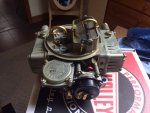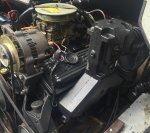Efini Motorsport
Petty Officer 2nd Class
- Joined
- Feb 21, 2018
- Messages
- 108
A few months ago I picked up a 90 Four Winns Freedom 195. I got the boat and trailer for $450 with an extra engine, 4 sets of heads, extra outdrive and a bunch of other parts. The interior is shot but the floors and everything structural is in great shape. I've already cut all new seating and panels. I'm converting from dual back to back with jump seats to a helm/jump seat starboard and a back to back/ lounge seat port side. I've gone through the wiring and everything that I didn't rip out is intact. I will be rewiring for all the new accessories, lighting, stereo, etc. Got some good ideas for that stuff too.
Where I'm hung up right now is what to do about the engine. The one in the boat is all there but full of water and at minimum needs to be torn down, inspected and rebuilt. The "extra" engine is already torn down and seems to be in good shape. Between them I have more than enough parts to build one good engine. I'm not sure if that's the route I want to go though. I've been building custom cars for almost 20 years and can handle any of the mechanical or electrical aspects no matter which route I take. I prefer to do things different than most though.
Option 1: Rebuild engine basically as stock using the best of the the pieces I have and replace what needs to be replaced. It will basically be an entirely stock motor with a holley 500cfm 2 barrel carb. Functional but rather boring.
Option 2: Rebuild and upgrade. It would be new stock internals with vortec heads, custom cam and the same holley carb. I'm looking at about another $600-700 over a stock rebuild. A little more fun but doesn't say custom enough to me.
Option 3: Pull a fuel injected 4.3 vortec from a newer truck and drop it in, fuel injection and all. This is actually the cheapest route but a little more work. I know I'll need an electric fuel pump, swirl tank or bladder for fuel tank and some rewiring and tuning. All things I can handle. If nothing else I could carb swap the motor. I actually found someone who did an FI setup on almost the same boat http:/tm/home.hiwaay.net/~davida1/boat.htm.
So what route should I go? The whole interior will be custom, all the electronics will be new with plenty of sound and LED lighting and the engine will be detailed out (yeah I know, I have a bad habit of double assing everything). Time aside it seems the new FI vortec would give me the most bang for the buck plus the cool factor.
My last questions is about the bat wing manifolds. I've got two sets that seem to be in pretty good shape, I had them sandblasted and will check them for leaks but for now I'm going to run the best pair of the two. I know most people say stay away from them but I think I've figured out a cheap temporary fix. I was thinking of using brass 1/4 turn valves on the drains of both manifolds. I keep them open until the engine is running then close them. I can open them back up before I shut the engine down to drain the jackets. That way the only time they're "wet" is when the engine is running so unless it's a huge leak it shouldn't be enough to hydrolock the engine.
Where I'm hung up right now is what to do about the engine. The one in the boat is all there but full of water and at minimum needs to be torn down, inspected and rebuilt. The "extra" engine is already torn down and seems to be in good shape. Between them I have more than enough parts to build one good engine. I'm not sure if that's the route I want to go though. I've been building custom cars for almost 20 years and can handle any of the mechanical or electrical aspects no matter which route I take. I prefer to do things different than most though.
Option 1: Rebuild engine basically as stock using the best of the the pieces I have and replace what needs to be replaced. It will basically be an entirely stock motor with a holley 500cfm 2 barrel carb. Functional but rather boring.
Option 2: Rebuild and upgrade. It would be new stock internals with vortec heads, custom cam and the same holley carb. I'm looking at about another $600-700 over a stock rebuild. A little more fun but doesn't say custom enough to me.
Option 3: Pull a fuel injected 4.3 vortec from a newer truck and drop it in, fuel injection and all. This is actually the cheapest route but a little more work. I know I'll need an electric fuel pump, swirl tank or bladder for fuel tank and some rewiring and tuning. All things I can handle. If nothing else I could carb swap the motor. I actually found someone who did an FI setup on almost the same boat http:/tm/home.hiwaay.net/~davida1/boat.htm.
So what route should I go? The whole interior will be custom, all the electronics will be new with plenty of sound and LED lighting and the engine will be detailed out (yeah I know, I have a bad habit of double assing everything). Time aside it seems the new FI vortec would give me the most bang for the buck plus the cool factor.
My last questions is about the bat wing manifolds. I've got two sets that seem to be in pretty good shape, I had them sandblasted and will check them for leaks but for now I'm going to run the best pair of the two. I know most people say stay away from them but I think I've figured out a cheap temporary fix. I was thinking of using brass 1/4 turn valves on the drains of both manifolds. I keep them open until the engine is running then close them. I can open them back up before I shut the engine down to drain the jackets. That way the only time they're "wet" is when the engine is running so unless it's a huge leak it shouldn't be enough to hydrolock the engine.





















